We looked at over four million featured snippets to determine how likely they are to stick around.
After you win that snippet, is it always yours? Will it stay on the SERP for long? If it goes, is it gone forever? Are there any factors that might predict its behaviour?
We re-entered the topsy-turvy world of featured snippets to find out exactly how volatile they are, and devised a research project just crazy enough to work. Over the course of 20 days, we tracked the daily happenings of over 200,000 keywords with a featured snippet, and then put them under the microscope.
What did we learn? That snippets are (way) less volatile than Mount Vesuvius. See how we set this research in motion, and then download the whitepaper to get all the awesome findings.
Read the whitepaper(PDF)Okay, this is actually Pu'u 'O'o on Kilauea, Hawaii
But isn’t she a beaut? She’s also more volatile than featured snippets.
Corralling keywords and collecting SERP data
In order to get our research up and running, we needed heaps and heaps of keywords. We decided to use the same list of one million high-CPC keywords (à la Russ Jones and Grepwords) from our previous snippet study so we could refresh that research at the same time — which you can find here.
Then it was time to get the SERP data rolling. We loaded our one million keywords into STAT and tracked them on a mobile device in Los Angeles, California. By going local over national, we know that Google thinks all of our snippets are the perfect fit for this one area.
After the first day of tracking, we had 232,451 keywords that returned a featured snippet, giving us the keyword set that we would carry on with for the remaining 19 days.
We gathered the following SERP data for each keyword:
- The top 20 results
- Rank
- Regional search volume
- Result type (list snippets, “People also ask” boxes, organic, etc.)
- URL
When everything was done and dusted, we had a whopping 96,145,970 rows of data to play with — that’s 232,451 keywords x 20 (give or take a few) results per keyword x 20 days.
We then exported all that fine, fine data into a SQL data base and countless Excel spreadsheets, and got down to business.
Setting up the analysis
With boatloads of data at our fingertips, we needed a simple yet meaningful framework to structure our analysis around.
We found that the best way to zero in on exactly how featured snippets behave on the SERP was to group our keywords by degrees of appearance and volatility — after all, smart keyword segmentation is key.
To do this, we needed to define, score, and scatter-plot.
Step 1: Apply a volatility score
We decided that a snippet displayed volatility if it switched URLs, disappeared from the SERP, or reappeared after a vanishing act. (We excluded instances where a snippet flipped format, but kept the same URL, because it’s still a win for the site in question.) Five or more changes in a 20-day period felt like a highly volatile snippet to us.
Using Boolean logic, we added one point per keyword each time any of the above volatility occurred from one day to the next.
For example, here’s what a volatility score of three could look like for two keywords:
Swipe for more →
| Keyword 1 | Day 1 | Day 2 | Day 3 | Day 4 | Day 5 |
| Featured snippet URL | cats.com | cats.com | – | dogs.com | cats.com |
| Points | 0 | 0 | 1 | 1 | 1 |
Vol 3, App 4
The snippet for this keyword disappeared, reappeared, then changed URL.
Swipe for more →
| Keyword 2 | Day 1 | Day 2 | Day 3 | Day 4 | Day 5 |
| Featured snippet URL | cats.com | – | cats.com | – | – |
| Points | 0 | 1 | 1 | 1 | 0 |
Vol 3, App 2
The snippet for this keyword disappeared, reappeared, and then vanished for good.
The highest volatility score attainable is 19 (the snippet changed every gosh darn day), and the lowest is 0 (the snippet stayed exactly the same the whole way through). A volatility score of 0–4 is low, and 5–19 is high.
Step 2: Apply an appearance score
Here, appearance is the number of days that Google deems a keyword “snippet-worthy.” We added one point per keyword each day a snippet was present on the SERP, and decided that a high appearance rate would be 14 or more days.
The maximum appearance score that a keyword can lay claim to is 20 (a snippet every day for 20 days), and the minimum is one (a snippet only appeared on the first day). An appearance score of 1–13 is low, and 14–20 is high.
Even though our definition of volatility includes a measure of appearance (reappearance), surfacing the total number of snippets for each keyword helps us better understand the nature of the volatility we see.
For instance, a volatility score of one for a keyword whose snippet appears every day, has a far different meaning than for a keyword whose snippet appears only once.
Step 3: Plot the scores
Finally, it was time to see where the two scores intersected for each keyword, and let the snippets fall where they may.
A preview of the findings
When we were done crunching the numbers and plotting the data points, we got analysing. One plan of attack was to segment our keywords by the degrees of volatility that their snippets possess.
- Low volatility, high appearance (dark yellow). These keywords had snippets that appeared frequently, but changed very little, if at all.
- Low volatility, low appearance (light yellow). Snippets for these keywords didn’t show up as often, but also didn’t change that much when they did.
- High volatility, high appearance (dark red). These keywords produced a lot of snippets that changed a lot of times.
- High volatility, low appearance (light red). These keywords returned few snippets that changed frequently.
The volatility-appearance matrix
This will capture the appearance and volatility of each keyword’s snippet.
Here’s where our 232,451 featured snippet keywords wound up:
Swipe for more →
| Quadrant | Number of keywords | Percent of keywords |
| Low volatility, high appearance | 204,294 | 87.88% |
| Low volatility, low appearance | 7,387 | 3.18% |
| High volatility, high appearance | 17,919 | 7.71% |
| High volatility, low appearance | 2,851 | 1.23% |
Steady as she goes
Turns out less than 10 percent of featured snippets are highly volatile.
As you can see, not only do the vast majority of our keywords have snippets that appear regularly, those snippets are super stable. This means that if you manage to snag a snippet, you’re likely to reap its rewards for the long haul. Well, the 20-day-long haul.
And that’s just the tip of the findings iceberg.
In the full study, we dig further into the logic of our matrix to see exactly what it’s telling us about featured snippets, like the number of keywords whose snippets showed not an ounce of volatility.
We also explore the number of URLs you’re typically up against, as well as examine any factors that might be tied to volatility — can format or source position help us predict what these SERP gems get up to?
Read the whitepaper(PDF)Want to see which of your keywords trigger a featured snippet you could steal? Say hello and request a demo!




